Peter the Hermit
Peter the Hermit (also known as Cucupeter,[1] Little Peter or Peter of Amiens;[2] c. 1050 – unknown) was a priest of Amiens and a key figure during the First Crusade.
Peter the Hermit | |
|---|---|
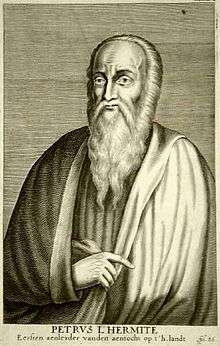 Portrait of Peter the Hermit c. 1667 by Cornelius Hazart | |
| Other names | Cucupeter, Little Peter or Peter of Amiens |
| Personal | |
| Born | c. 1050 |
| Died | Unknown |
| Religion | Christianity |
| Other names | Cucupeter, Little Peter or Peter of Amiens |
| Occupation | Priest |
| Church | Catholic church |
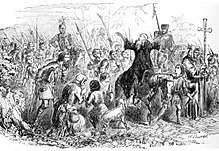
Family
His name in French is Pierre l'Ermite. The structure of this name in French unlike in English has led some francophone scholars to treat l'Ermite as a surname rather than a title.
According to some authors, he was born around 1050 and was the son of Renauld L'Ermite of Auvergne, and his wife Alide Montaigu, de Picardie.[3] Others claim he was a member of the L'Hermite family of Auvergne in the Netherlands.[4] These claims are disputed by other authors, who argue that nothing can confirm that "the Hermit" was an actual surname and that surnames had not developed until after his day.[5][6]
Before 1096
According to Anna Comnena, Peter had to go on a pilgrimage to Jerusalem before 1096 ,[7] but was prevented by the Seljuk Turks from reaching his goal and was reportedly mistreated. This was used to preach inflammatory statements about the Turks toward upset Christians.[8] However, doubts remain whether he ever made such a journey.[9]
Sources differ as to whether he was present at Pope Urban II's famous Council of Clermont in 1095. It is certain that he was one of the preachers of the crusade in France afterward, and his own experience may have helped to give fire to the Crusading cause. Tradition in Huy holds that he was there when the crusade was announced and he began his preaching at once. He soon leapt into fame as an emotional revivalist, and the vast majority of sources and historians agree that thousands of peasants eagerly took the cross at his bidding.[7]
Jonathan Riley-Smith has proposed that the People's Crusade also included well-armed soldiers and nobles. This part of the crusade was also known as the crusade of the "paupers", a term which in the Middle Ages indicated a status as impoverished or mendicant wards of the Church. Peter organized and guided the paupers as a spiritually purified and holy group of pilgrims who would, supposedly, be protected by the Holy Ghost. (A list of known participants in Peter's army can be found at The Digital Humanities Institute.[10])
Crusade to the Holy Land
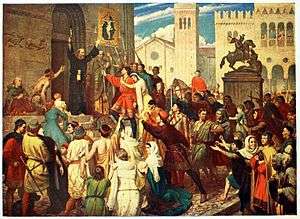
Before Peter went on his crusade he received permission from Patriarch Simeon II of Jerusalem.[11] Peter was able to recruit from England, Lorraine, France, and Flanders.[11] Peter the Hermit arrived in Cologne, Germany, on Holy Saturday, the 12th of April in 1096.[12] In the spring of 1096 Peter was one of the prominent crusader leaders involved in the Rhineland massacres against the Jews. [13] Peter and his followers participated in the torture and slaughter of Jews in Lorraine, Cologne, and Mainz.[11] In Mainz, Peter's followers killed a large group of Jews that had been granted refuge by a local bishop.
Leading the first of the five sections of the People's Crusade to the destination of their pilgrimage, the Church of the Holy Sepulchre, he started (with 40,000 men and women) from Cologne in April, 1096, and arrived (with 30,000 men and women) at Constantinople at the end of July. The Eastern Roman Emperor Alexios I Komnenos was less than pleased with their arrival, for along with the head of the Eastern Orthodox Church, Patriarch Nicholas III of Constantinople, he was now required to provide for the care and sustenance of the vast host of paupers for the remainder of their journey.
Before reaching Constantinople though, Peter and his followers began to experience difficulty.[12] In Zemun, the Governor, who was descendant of a Ghuzz Turk, and a colleague, were frightened by the army's size and decided to tighten regulations on a frontier. This would have been fine if a dispute about the sale of a pair of shoes had not occurred.[12] This led to a riot and against Peter's wishes the town was attacked and the citadel was stormed. This resulted in 4000 Hungarians being killed and many provisions being stolen. Then on June 26, 1096 Peter's army was able to cross the Sava river. Then the army marched into Belgrade, set the town on fire, and pillaged it.[12] The army then made its way into and through Niš after an eight-day delay. After riding through Nish the Crusaders made their way towards Sofia when they were attacked on the road. The army took heavy losses. They lost 1/4 of their men but arrived in Sofia on July 12 nonetheless.[12] The forces then arrived in Constantinople on August 1, 1096. After a while, they arrived at a castle called Xerigordon and captured it. They captured the castle by taking possession of the castle's spring and well. After setting off to Civetot, they had set up camp near a village called Dracon. This is where the Turks ambushed Peter and his forces. This was the final battle of the People's Crusade that Peter led.
Most of the paupers failed to make their way out of Catholic jurisdiction. The majority were incapable of being provided for by the various lordships and dioceses along the way and either starved, returned home or were put into servitude, while a substantial number were captured and sold into slavery by the various Slavic robber barons in the Balkans, kindling the view of the Balkan Slavs as unredeemed robbers and villains.
Peter joined the only other section which had succeeded in reaching Constantinople,[7] that of Walter Sans Avoir, into a single group and encamped the still numerous pilgrims around Constantinople while he negotiated the shipping of the People's Crusade to the Holy Land. The Emperor meanwhile had failed to provide for the pilgrims adequately and the camp made itself a growing nuisance, as the increasingly hungry paupers turned to pilfering the imperial stores.

Alexios, worried at the growing disorder and fearful of his standing before the coming armed Crusader armies, quickly concluded negotiations and shipped them across the Bosporus to the Asiatic shore at the beginning of August, with promises of guards and passage through the Turkish lines. He warned the People's Crusade to await his orders, but in spite of his warnings, the paupers entered Turkish territory. The Turks began skirmishing with the largely unarmed host. Peter returned in desperation to Constantinople, seeking the Emperor's help.

In Peter's absence, the pilgrims were ambushed and cut to pieces in detail by the Turks, who were more disciplined, at the Battle of Civetot. Despite Peter's pronunciations of divine protection, the vast majority of the pilgrims were slaughtered by the swords and arrows of the Turks or were enslaved. Left in Constantinople with the small number of surviving followers, during the winter of 1096–1097, with little hope of securing Byzantine support, the People's Crusade awaited the coming of the armed crusaders as their sole source of protection to complete the pilgrimage.
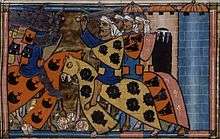
When the princes arrived, Peter joined their ranks as a member of the council in May 1097, and with the little following which remained they marched together through Asia Minor to Jerusalem. While his "paupers" never regained the numbers previous to the Battle of Civetot, his ranks were increasingly replenished with disarmed, injured, or bankrupted crusaders. Nonetheless, aside from a few rousing speeches to motivate the Crusaders, he played a subordinate part in the remaining history of the First Crusade which at this point clearly settled on a military campaign as the means to secure the pilgrimage routes and holy sites in Palestine.
Peter appears, at the beginning of 1098, as attempting to escape from the privations of the siege of Antioch—showing himself, as Guibert of Nogent says, a "fallen star." Guibert and other sources go on to write that Peter was responsible for the speech before the half-starved and dead Crusaders which motivated their sally from the gates of Antioch and their subsequent crushing defeat of the overwhelmingly superior Muslim army besieging the city. Thus, having recovered his stature, in the middle of the year he was sent by the princes to invite Kerbogha to settle all differences via a duel,[7] which the Emir subsequently declined.
In 1099 Peter appears as the treasurer of the alms at the siege of Arqa (March), and as leader of the supplicatory processions around the walls of Jerusalem before it fell, and later within Jerusalem which preceded the Crusaders' surprising victory at the Battle of Ascalon (August). At the end of 1099, Peter went to Latakia, and sailed thence for the West. From this time he disappears from the historical record. Albert of Aix records that he died in 1131, as prior of a church of the Holy Sepulchre which he had founded in France.[7]
Role in Preaching First Crusade
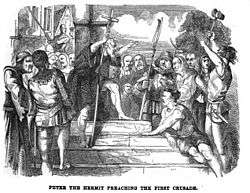
Although later Catholic historians and many other scholars disagree, Roger of Wendover and Matthew Paris wrote that Peter the Hermit was the true author and originator of the First Crusade, a view also recounted in the anonymous Gesta Francorum – written c. 1100 – and by Albert of Aix in his Historia Hierosolymitanae Expeditionis,[14] and also supported by some modern scholars.[15][16]
Such historical sources recount that during an early visit to Jerusalem sometime before 1096, Jesus appeared to Peter the Hermit in the Church of the Holy Sepulchre, and bade him preach the crusade. This story also appears in the pages of William of Tyre, which indicates that even a few generations after the crusade, the descendants of the crusaders already believed Peter was its originator. The origin of such a legend is a matter of some interest. Von Sybel, in his Geschichte des ersten Kreuzzuges, published in 1841, suggested that in the camp of the paupers (which existed side by side with that of the knights, and grew increasingly large as the crusade took a more and more heavy toll on the purses of the crusaders) some idolization of Peter the Hermit had already begun, parallel to the similar glorification of Godfrey by the Lorrainers.[7]

Later life
There is very little concrete record for his life after returning to Europe and much of what we do know is speculation or legend. However, Albert of Aix records that he died in 1131, as prior of a church of the Holy Sepulchre which he had founded in France[17][18][7] or Flanders. It is thought that during the Siege of Antioch during the days of famine and cold weather,[8] Peter attempted to flee only to be captured by the Norman Tancred and placed back on the battlefield in 1112[1]. Peter also held services of intercession for Latin and native recruits. Peter advised Greeks and Latins to form processions as well.[8]
It is generally quoted that he founded an Augustinian monastery in France named for the Church of the Holy Sepulchre. However, it was actually in Flanders[17][18] at Neufmoustier near Huy,[19] or Huy itself which may have been his home town. His tomb is in the Neufmoustier Abbey, so it is presumed that this was his Abbey but in another tradition the nearby Solières Abbey claims that it was his foundation.
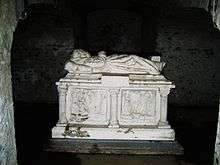
Peter's obituary is in the chronicle of Abbey Neufmoustier Huy.[20] On its page entry of 8 July 1115 the chronicle says that this day saw "the death of Dom Pierre, of pious memory, venerable priest and hermit, who deserved to be appointed by the Lord to announce the first to the holy Cross" and the text continues with "after the conquest of the holy land, Pierre returned to his native country" and also that "he founded this church ... and chooses them a decent burial". This record further supports Neufmoustier's claim as his foundation.
Legend
Since his death various legends have sprung up around Peter. One legend has its roots in the writings of Jacques de Vitry, who found it convenient to convince people from the bishopric of Liège of the merits of participating in the Albigensian Crusade by manipulating the story of Peter.[21][22]
Another legend is given in the 14th century by the French troubadour Jehan-de-Bouteiller, who sings the memory of "a dict Peter the Hermit deschendant a count of Clairmont by a Sieur d'Herrymont [who] married a Montagut". Peter the Hermit's parents would, therefore, be Renauld de Hérimont and Aleidis Montaigu (Aleidis is known in Huy as the "mother of Dom Pierre, with a home in Huy").[23]
There is also a strong and old tradition that Peter the Hermit was the first to introduce the use of the Rosary.[17][18] It follows that he began this tradition in about 1090.[24] If this is the case and if he had also been on a previous pilgrimage to Jerusalem, it is possible that he derived this practice from similar Islamic practices.
References
- Comnena, Anna. The Alexiad: Book X. Fordham University.
- Snell, Melissa. "Peter the Hermit". About.com. Retrieved 2015-10-19.
- "Bienheureux Pierre l'Ermite". nominis.cef.fr. Retrieved 2016-03-30.
- Léon Paulet, Recherches sur Pierre l'Hermite et la Croisade, (Ve Jules Renouard, 1856) p72.
- Heinrich Hagenmeyer, Le vrai et le faux sur Pierre l'Hermite: analyse critique des témoignages historiques relatifs à ce personnage et de légendes auxquelles il a donné lieu (Librairie de la Société Bibliographique, 1883) p 32.
- Dr M. Hoefer (dir.), Nouvelle Biographie Générale, vol. 40, Paris, Firmin-Didot, 1862, p.184.
-

- Hill, John (1987). Strayer, Joseph (ed.). Dictionary of The Crusades. New York: American Council of Learned Studies. p. 523.
- Herbermann, Charles, ed. (1913). . Catholic Encyclopedia. New York: Robert Appleton Company.
- "A Database of Crusaders to the Holy Land: Peter the Hermit".
- Edwards, Peter (1998). The Chronicle of Fulcher of Chartres and Other Source Materials. Philadelphia: University of Philadelphia Press. pp. 102–157.
- Runciman, Steven (1954). A History of the Crusades. Cambridge University: Cambridge University Press. pp. 121–133.
- Robert Chazan (1996). European Jewry and the First Crusade. U. of California Press. pp. 55–58.
- "Historia Hierosolymitanae Expeditionis". Retrieved 2012-07-25.
- Flori, Jean. Pierre l' Ermite et la première croisade, Éditions Fayard, 1999
- Blake, E.O. and Morris, Colin. Peter and the Origins of the First Crusade, Studies in Church History, vol 22, pp.440-453. Oxford, 1985.
- Thomas Dudley Fosbroke, British Monachism; Or, Manners and Customs of the Monks and Nuns of England (etc.) 3. Ed (John Bowyer Nichols, 1843)p 317.
- William Hurd, A New Universal History of the Religious Rites, Ceremonies, and Customs of the Whole World: Or, A Complete and Impartial View of All the Religions in the Various Nations of the Universe Both Ancient and Modern, from the Creation Down to the Present Time: To which is Added, a Geographical Description of the Various Parts, the Religious Rites and Ceremonies of Whose Inhabitants are Described, (J. Hemingway, 1799) p255.
- Peter the Hermit at Britanica online.
- l'original de cet obituaire se trouve au musée Curtius à Liège, page of 8 July 1115.
- ul de Saint-Hilaire, Liège et Meuse mystérieux, vol. 2, Bruxelles, édition Rossel, 1982.
- Les grands Mythes de L'histoire de Belgique, de Flandre et de Wallonie, Evo-histoire, 1996
- Pierre d'Hérimont dit l'Ermite by Freddy Van Daele, édition Alfred Van Daele, Hosdent-sur-Mehaigne,2008
- Peter the Hermit at Britanica online.
Sources
| Wikimedia Commons has media related to Peter the Hermit. |
- "Peter the Hermit", Famous Men of the Middle Ages
- Prof. J. S. C. Riley-Smith, Prof, Jonathan Phillips, Dr. Alan V. Murray, Dr. Guy Perry, Dr. Nicholas Morton, A Database of Crusaders to the Holy Land, 1099-1149 (available on-line)